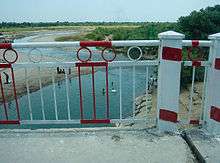Hari (Afghanistan)
The Hari River (Dari: هری رود, romanized: Harī Rōd; Pashto: د هري سیند) or Herat River is a river flowing 1,100 kilometres (680 mi) from the mountains of central Afghanistan to Turkmenistan, where it forms the Tejend oasis and disappears in the Karakum Desert.

| Hari | |
|---|---|
 |
In Turkmenistan it is known as the Tejen or Tedzhen river and passes close to the city of Tedzhen. To the Ancient Greeks it was known as the Arius.[1] In Latin, it was known as the Tarius.
Course
The river originates in the Baba mountain range, part of the Hindu Kush system, and follows a relatively straight course to the west.
Still some 200 kilometres (120 mi) upstream from Herat the river meets the Jam River at the site of the Minaret of Jam, the second tallest ancient minaret in the world at 65 metres (213 ft).
In western Afghanistan the Hari Rud flows to the south of Herat. The valley around Herat was historically famous for its fertility and dense cultivation. After Herat, the river turns northwest, then north, forming the northern part of the border between Afghanistan and Iran. Farther north it forms the south-eastern part of the border between Iran and Turkmenistan. The Iran–Turkmenistan Friendship Dam is on the river.[2]
The Afghan-India Friendship Dam (Salma Dam) is a hydroelectric and irrigation dam project located on the Hari Rud in Chishti sharif District of Herat Province in western Afghanistan.
In 2000, the river dried up completely during a 10-month drought.[3]
Ancient references
The Rigveda is said to have recorded the Hereyrud as the River Sarayu.[4] The river Horayu is also mentioned in the Avesta.[5] A Buddhist monastery hand-carved in the bluff of the river Hereyrud existed in the first centuries during the prevalence of Buddhism. The artificial caves revealed testimony of daily life of the Buddhist monks.[6]
External links
- UNESCO: Minaret of Jam (Press Release No.2002-41) and Minaret and Archaeological Remains of Jam (World Heritage List entry).
- University of Texas: A map showing the river (as 'Hariru').
- A mention of the Tedzhen river (inaccessible on 2013-06-26).
See also
References
- George Rawlinson (1873). The sixth great Oriental monarchy; or The geography, history, & antiquities of Parthia, collected and illustrated from ancient and modern sources. pp. 69, 444(index).
- Shroder, John F. (2016). "Hari Rud – Murghab River Basin". Transboundary Water Resources in Afghanistan: Climate Change and Land-Use Implications. Saint Louis: Elsevier. pp. 410–412. ISBN 978-0-12-801861-3.
- Parvand News Jan 3, 2001
- Early Aryans of India, 3100-1400 B.C. By S. B. Roy Page 76
- Legend of Ram: antiquity to janmabhumi debate By Sanujit Ghose.Page 77
- Lithuanian archeologists make discovery in Afghanistan, The Baltic Times, May 22, 2008; Archaeologists make new discoveries about ancient Afghan cultures, Top News, 23 May 2008.